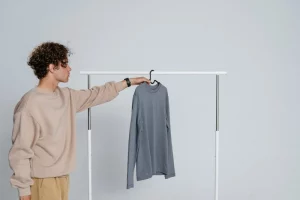
Building a wardrobe that’s both stylish and sustainable is a goal that many fashion-conscious individuals are striving toward. With growing concerns over environmental impact and ethical practices in the fashion industry, more people are looking for ways to create a wardrobe that aligns with their values. But how can you build a wardrobe that’s eco-friendly without sacrificing style? In this article, we’ll explore practical steps for achieving just that.
The Importance of Sustainable Fashion
Why Sustainability Matters in Fashion
Fashion is one of the most resource-intensive industries in the world, contributing to pollution, waste, and unethical labor practices. According to research, the fashion industry is responsible for about 10% of global carbon emissions and is the second-largest consumer of water globally. By opting for a sustainable wardrobe, you can minimize your environmental footprint while still expressing your personal style.
Sustainable fashion isn’t just about being environmentally conscious—it’s also about supporting ethical practices and creating a more equitable industry. By making mindful decisions, we can shift the industry toward better practices and become part of the solution, not the problem.
What Is a Sustainable Wardrobe?
Defining Sustainability in Fashion
A sustainable wardrobe is built on principles that focus on minimizing waste, reducing environmental impact, and ensuring that the production processes of your clothing are ethical. It means investing in pieces that are durable, timeless, and versatile, choosing brands that value ethical manufacturing, and adopting mindful shopping habits.
A sustainable wardrobe doesn’t mean sacrificing style; it simply encourages a shift from fast fashion to a more thoughtful, quality-over-quantity approach. This not only helps the planet but also saves you money in the long run.
Key Principles of a Sustainable Wardrobe
- Quality over Quantity: Choose well-made garments that will last for years rather than disposable, trendy pieces.
- Durability: Opt for fabrics that stand the test of time and are less likely to wear out after a few washes.
- Versatility: Invest in clothing that can be styled in multiple ways and for various occasions.
Assessing Your Current Wardrobe
Understanding What You Already Own
Before you can begin building a sustainable wardrobe, it’s essential to evaluate your existing clothes. Take a moment to go through your wardrobe and assess what you have. You might be surprised by how many versatile, high-quality pieces are already in your collection.
Take Stock of What You Have
Start by sorting your clothes into categories: items you wear regularly, occasional wear, and items you no longer use. This process will help you identify what’s truly essential and what might be weighing down your wardrobe. By donating or recycling items you no longer wear, you can start fresh without contributing to waste.
Identify Gaps in Your Wardrobe
Once you’ve done a clean-out, take note of what’s missing. Perhaps you need a versatile pair of jeans, a classic blazer, or a quality pair of shoes. A sustainable wardrobe doesn’t mean you need to buy everything at once; it’s about filling gaps with pieces that will complement your existing wardrobe and stand the test of time.
Building a Sustainable Wardrobe from Scratch
Steps to Create a Sustainable Wardrobe
When starting from scratch, it’s essential to focus on making deliberate and thoughtful choices. Here are some steps you can take to build a sustainable wardrobe that reflects both your style and values.
Choose High-Quality Materials
The materials used in clothing production play a huge role in its sustainability. Opt for natural fibers like organic cotton, wool, hemp, and linen, as well as recycled materials like polyester or nylon made from plastic bottles. These fabrics are not only more sustainable but also tend to be more durable.
Prioritize Timeless Pieces
One of the key strategies in building a sustainable wardrobe is investing in timeless, classic pieces that won’t go out of style. Think of items like a tailored blazer, a white button-down shirt, or a little black dress. These staples can be worn year-round, styled in different ways, and paired with various accessories to create a wide range of outfits.
The Capsule Wardrobe Approach
A capsule wardrobe is a minimalist approach to dressing where you focus on owning a small number of high-quality, versatile pieces that can be mixed and matched. This approach not only reduces clutter but also helps you make more intentional decisions when it comes to adding new pieces.
Benefits of a Capsule Wardrobe
By curating a wardrobe of carefully chosen pieces, you’ll have more options with fewer items. The focus is on versatile, multi-functional pieces that can create countless outfits with minimal effort. Plus, it encourages you to buy less while still having a fully functional wardrobe.
Essential Pieces for a Capsule Wardrobe
Some essential pieces for a capsule wardrobe include:
- A well-fitting pair of jeans
- A white or black shirt
- A neutral blazer
- A simple dress (that works for both casual and formal settings)
- A versatile pair of shoes (think ballet flats or ankle boots)
Ethical and Sustainable Brands
How to Identify Fashion Brands with Sustainable Practices
Sustainable fashion brands focus on using eco-friendly materials, ensuring fair wages for workers, and employing ethical manufacturing processes. Look for certifications like Fair Trade, GOTS (Global Organic Textile Standard), or B Corp when shopping for sustainable brands.
Supporting Local and Small Brands
Supporting local and small sustainable brands is another excellent way to contribute to a more ethical fashion industry. These brands often have more transparency and direct relationships with their workers, allowing for a more ethical supply chain.
Conscious Shopping Practices
How to Shop Mindfully Without Compromising Style
Mindful shopping means being intentional about your purchases. Rather than buying into fast fashion trends, focus on pieces that truly suit your style and needs. Consider the longevity of the item, the quality of the materials, and how it fits into your current wardrobe.
Buy Less, Choose Wisely
One of the pillars of sustainable fashion is reducing consumption. Instead of buying multiple items for a single season, focus on selecting pieces that you can wear year-round. Choose quality over quantity, and make each purchase count.
Secondhand and Vintage Shopping
Secondhand shopping is one of the most sustainable ways to build your wardrobe. Vintage and thrift shops offer unique items that often have a longer lifespan than fast fashion pieces. Plus, shopping secondhand reduces waste and gives pre-loved items a second life.
Benefits of Secondhand Clothing
Secondhand shopping not only reduces waste but also often provides more affordable options compared to buying new. You can find high-quality, unique pieces that will last longer and help you stand out from the crowd.
How to Shop Secondhand with Style
To shop secondhand effectively, keep an open mind and focus on finding pieces that fit your style. Vintage clothing stores often carry items that are made of high-quality fabrics and feature unique designs, offering a way to build a distinctive, sustainable wardrobe.
Caring for Your Clothes
How Proper Maintenance Can Extend the Life of Your Clothes
Taking care of your clothing is essential for ensuring longevity. Proper washing, storing, and repairing clothes can significantly extend their lifespan, helping to reduce waste and the need for constant shopping.
Washing and Storing Clothes Properly
Use gentle detergents, wash clothes on cold settings, and avoid over-drying to maintain the integrity of fabrics. Storing clothes in a cool, dry place and using garment bags can also help preserve their condition.
Repairing and Upcycling
If your clothes start to show signs of wear, don’t toss them out—repair them! Sewing buttons, fixing hems, or re-styling an old garment can breathe new life into your wardrobe. Upcycling is a creative way to turn outdated clothes into something new and exciting.
Conclusion
Building a sustainable wardrobe doesn’t have to mean sacrificing style. By focusing on high-quality materials, timeless pieces, and conscious shopping practices, you can create a wardrobe that’s both eco-friendly and fashionable. Remember, it’s about making thoughtful choices, supporting ethical brands, and taking care of what you own to reduce waste and promote longevity. Sustainable fashion is not just a trend; it’s the future of style.

FAQs
- How can I start building a sustainable wardrobe on a budget? Focus on secondhand shopping, buy quality over quantity, and invest in timeless pieces that can be worn year-round.
- Are there any sustainable brands that offer trendy pieces? Yes! Many sustainable brands offer fashionable items that are both stylish and eco-friendly. Look for those that use organic materials or recycled fabrics.
- How can I maintain my clothes to make them last longer? Wash clothes on a gentle cycle, avoid excessive heat, and repair any damage promptly to extend their lifespan.
- What are some good sustainable fabric options? Organic cotton, hemp, bamboo, and Tencel are all great eco-friendly fabric choices that are durable and sustainable.
- How does shopping secondhand help the environment? Buying secondhand reduces waste, minimizes the demand for new production, and gives old clothing a second life, lowering the overall environmental impact.






